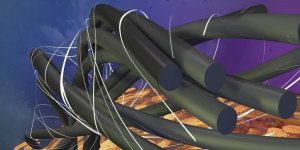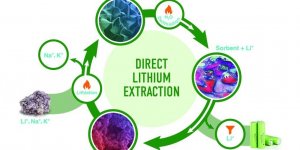Tech News

When hurricanes threaten tropical shores, “super grids” could come to the rescue. »

Scientists at the Department of Energy’s Oak Ridge National Laboratory have developed a method that demonstrates how fiber-reinforced polymer composite materials used in the automotive, aerospace and renewable energy industries can be made stronger and tougher to better withstand mechanical or structural stresses over time. »

Chemists at the Department of Energy’s Oak Ridge National Laboratory have invented a more efficient way to extract lithium from waste liquids leached from mining sites, oil fields and used batteries. »

An international team of scientists found a way to improve battery design that could produce safer, more powerful lithium batteries. »

Cotton gin waste, also known as cotton gin trash, is a byproduct of the cotton ginning process and occurs when the cotton fibers are separated from the seed boll. For cotton gin waste, the treasure is its hidden potential to transform silver ions into silver nanoparticles and create a new hybrid material that could be used to add antimicrobial properties to consumer products, like aerogels, packaging, or composites. »

NIH scientists use artificial intelligence called ‘P-GAN’ to improve next-generation imaging of cells in the back of the eye. »

Driver uncertainty about access to charging during long trips remains a barrier to broader EV adoption, even as the U.S. strives to combat climate change by converting more drivers. »

Researchers at the Department of Energy’s Oak Ridge National Laboratory are taking cleaner transportation to the skies by creating and evaluating new batteries for airborne electric vehicles that take off and land vertically. »

A team that included researchers at the Department of Energy’s Oak Ridge National Laboratory used a new twist on an old method to detect materials at some of the smallest amounts yet recorded. »

Researchers at the Agricultural Research Service's Eastern Regional Research Center in Wyndmoor, Pa., used a novel thermal technology that pasteurizes eggs and inactivates Salmonella cells with a short processing time. »

University of Pennsylvania engineers have developed a new chip that uses light waves, rather than electricity, to perform the complex math essential to training AI. »

In a win for chemistry, inventors at the Department of Energy’s Oak Ridge National Laboratory have designed a closed-loop path for synthesizing an exceptionally tough carbon-fiber-reinforced polymer, or CFRP, and later recovering all of its starting materials. »

Researchers have developed a sensor made from ‘frozen smoke’ that uses artificial intelligence techniques to detect formaldehyde in real time at concentrations as low as eight parts per billion, far beyond the sensitivity of most indoor air quality sensors. »

Oak Ridge National Laboratory researchers have developed a novel way to encapsulate salt hydrate phase-change materials within polymer fibers through a coaxial pulling process. »

Results could help pave the way for quantum infrastructure. »

Researchers have developed an augmented reality head-up display that could improve road safety by displaying potential hazards as high-resolution three-dimensional holograms directly in a driver’s field of vision in real time. »

The University of Tokyo scientists have achieved a breakthrough by integrating large language models (LLMs) with robots, marking a significant stride in enabling more humanlike gestures without relying on conventional hardware-driven controls. »

An international team of researchers has developed a handheld, non-invasive device that can detect biomarkers for Alzheimer's and Parkinson's disease. »

For the first time, researchers demonstrate how to electronically alter the direction of electron flow in promising materials for quantum computing. »

German company Cerabyte recently tested a prototype of its own data storage system using ceramic media, potentially heralding a shift away from traditional HDDs and SSDs in data centers by 2030. »

Dynamic crystallization control solves 2D halide perovskite synthesis bottleneck. »

Guided by machine learning, chemists at the Department of Energy’s Oak Ridge National Laboratory designed a record-setting carbonaceous supercapacitor material that stores four times more energy than the best commercial material. »

X-ray laser shows possible route to substantially increased precision time measurement. »

A floating, solar-powered device that can turn contaminated water or seawater into clean hydrogen fuel and purified water, anywhere in the world, has been developed by researchers. »

Graphene byproduct offsets 'flash' hydrogen production costs. »

Additive mixture stabilizes phase change material, unlocks potential for heat pumps. »

Neuron processes visual and tactile input together. »

Researchers develop novel bubble-based technique to watch immune cells at work. »

Sensitive technique could revolutionize treatment during pandemics. »

An international group of scientists based in Russia’s National Research University of Electronic Technology (MIET) have managed to promote glycine crystals' piezoelectric effect - where an electric charge is produced by applying pressure. »

Researchers tracked how current language models such as ChatGPT mistake nonsense sentences as meaningful. »

As current courses through a battery, its materials erode over time. Mechanical influences such as stress and strain affect this trajectory, although their impacts on battery efficacy and longevity are not fully understood. »

High energy density batteries could potentially outperform lithium-ion batteries. »

New technique produces perovskite nanocrystals right where they're needed. »



